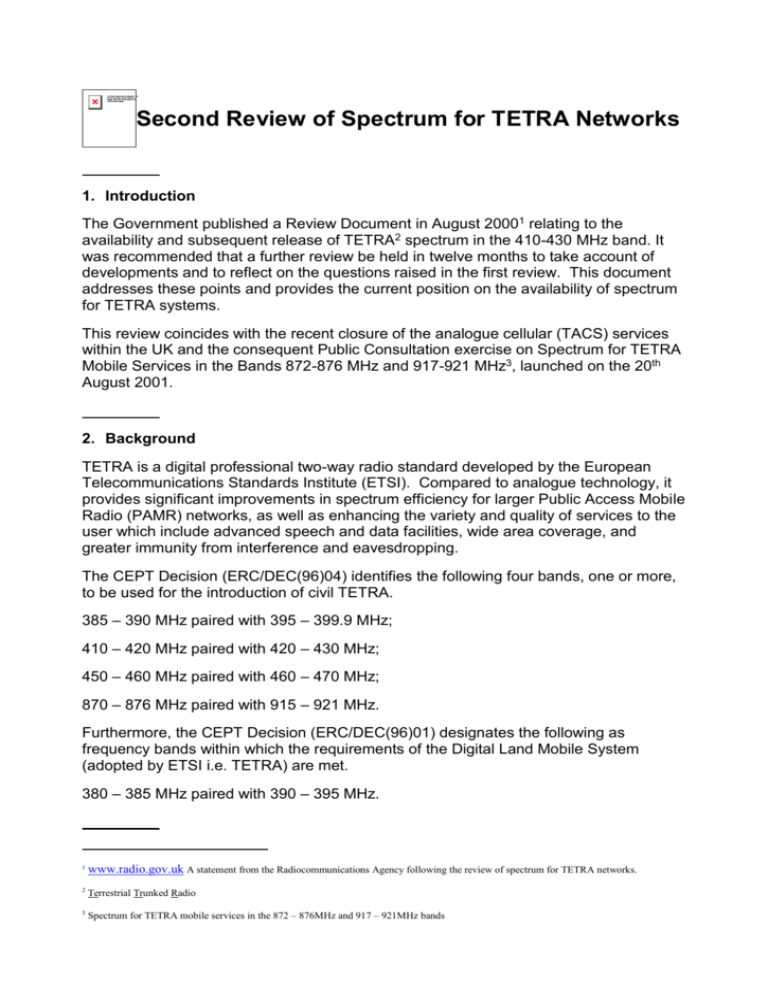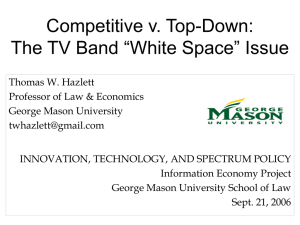Second Review of Spectrum for TETRA Networks
advertisement

Second Review of Spectrum for TETRA Networks 1. Introduction The Government published a Review Document in August 20001 relating to the availability and subsequent release of TETRA2 spectrum in the 410-430 MHz band. It was recommended that a further review be held in twelve months to take account of developments and to reflect on the questions raised in the first review. This document addresses these points and provides the current position on the availability of spectrum for TETRA systems. This review coincides with the recent closure of the analogue cellular (TACS) services within the UK and the consequent Public Consultation exercise on Spectrum for TETRA Mobile Services in the Bands 872-876 MHz and 917-921 MHz3, launched on the 20th August 2001. 2. Background TETRA is a digital professional two-way radio standard developed by the European Telecommunications Standards Institute (ETSI). Compared to analogue technology, it provides significant improvements in spectrum efficiency for larger Public Access Mobile Radio (PAMR) networks, as well as enhancing the variety and quality of services to the user which include advanced speech and data facilities, wide area coverage, and greater immunity from interference and eavesdropping. The CEPT Decision (ERC/DEC(96)04) identifies the following four bands, one or more, to be used for the introduction of civil TETRA. 385 – 390 MHz paired with 395 – 399.9 MHz; 410 – 420 MHz paired with 420 – 430 MHz; 450 – 460 MHz paired with 460 – 470 MHz; 870 – 876 MHz paired with 915 – 921 MHz. Furthermore, the CEPT Decision (ERC/DEC(96)01) designates the following as frequency bands within which the requirements of the Digital Land Mobile System (adopted by ETSI i.e. TETRA) are met. 380 – 385 MHz paired with 390 – 395 MHz. 1 www.radio.gov.uk A statement from the Radiocommunications Agency following the review of spectrum for TETRA networks. 2 Terrestrial Trunked Radio 3 Spectrum for TETRA mobile services in the 872 – 876MHz and 917 – 921MHz bands 3. Review of TETRA Designated Bands 3.1 380 – 400MHz Band This band is segmented into civil and military (NATO) use. The civil spectrum (380 – 385 paired with 390 – 395MHz) is to be used in the UK and many European countries by the emergency services, e.g. police and fire services. BT Airwave will roll out the network following successful completion of a pilot. 2004 should complete this roll out. The closure of existing services will help facilitate band re-alignment discussed in 3.3. The band 385-390 MHz paired with 395-399.9 MHz is for continuing NATO military use. 3.2 410 – 430MHz Band This band was heavily used by the military. Over the past year, the RA has coordinated the migration of many of these services out of this spectrum and this process will continue. The continuing analogue military and private mobile radio use of this band still however presents problems in gaining access for TETRA networks. The current position is that there is only sufficient spectrum for one public TETRA operator. Dolphin Telecom is the sole UK public TETRA operator. Dolphin’s access to further spectrum is on a basis of continuing demonstrable need. At present they have approximately 2 x 4MHz of national spectrum. Meeting Dolphin’s validated demand for spectrum has meant that the significant demand for private TETRA spectrum has not been met in this band. The RA is exploring all options for identifying spectrum for private TETRA systems and the work done in RA’s CTEC committee is the focus for all interested parties. The RA is confident that another 2 x 1MHz should become available in the medium term for TETRA use, but progress beyond that point will be difficult in the short to medium term due to the continuing use of the band by analogue private mobile radio systems. The situation is further complicated by the use of short-range devices (SRDs) in the 418MHz band, although this SRD band will be closed from December 2007. 3.3 450 – 470MHz This band is heavily used by analogue private, public and governmental mobile radio systems. The band is subject to the band-reversal exercise to align UK use with continental Europe. The RA has been working closely with representatives of the various interest groups and a detailed plan is emerging that aims to minimise disruption to the maximum extent possible and release spectrum in a phased manner to produce contiguous blocks wherever possible. The key development that will permit this exercise to start in earnest is the migration of the Home Office emergency services by December 2004. The band will be available to new digital systems shortly thereafter. 3.4 870-876 / 915-921 MHz Band Following the closure of the analogue cellular band (TACS), the Government has published a Consultative Document (20th August 2001) seeking comments on its proposal to award 2 x 4MHz of spectrum to Dolphin for its TETRA release 2 system. The band in question is between 872-876 and 917-921 MHz and includes guard bands and sharing arrangements will have to be coordinated with the MoD. Comments on the proposals within the Consultative Document are sought by Friday 9 th November 2001. - Private TETRA The RA allocated 2 x 1 MHz of spectrum for private TETRA use, last September (871 – 872 paired with 916 – 917MHz). Some interest has been expressed but, as equipment is currently unavailable, the RA has not received any applications for licences. There is a market for TETRA at 800MHz outside Europe and it may be possible to use this as the basis for developing equipment at 900MHz. RA propose to retain the current allocation for private TETRA but has sought views on this position in the Consultation on the future use of the 872-876 MHz paired with 917-921 MHz band. The current 900MHz consultation entitled “Spectrum for TETRA Mobile Services in the 872 – 876 MHz and 915– 921MHz Bands”, also contains a proposal that the RA will explore the scope for private TETRA systems to re-use some of this spectrum in areas outside major conurbation’s. - Public TETRA The proposal contained in the current consultation document 3 is to award the 872 – 876/915 – 921MHz band to Dolphin Telecom for a TETRA release 2 network. Comments on the proposals are sought by the 9th November 2001. 3.5 non-harmonised Bands To facilitate the introduction of TETRA in the UK, noting the limited availability of spectrum for private TETRA networks, the RA has stated that they will look favourably at any proposal to use existing private mobile radio bands by replacing existing analogue equipment. This offer remains on the table. However, such a proposal lacks the volume of scale that a harmonised band would offer and thus would be less attractive to a potential equipment manufacturer, unless volume orders are to be placed by large players or consortia. 4. Future Developments 4.1 Private TETRA As mentioned in previous sections of this document there are a number of options and initiatives that are either available now or may become available in the near future. The RA will continue to explore all avenues in the quest to identify additional spectrum for private TETRA systems. The current position has improved compared to this time last year but much remains to be done. The RA is not complacent and will continue to work with those interested in furthering private TETRA systems in the UK. The RA will also be working with all interested parties to expedite the process of band realignment in the 450-470 MHz band. The 450-470 MHz band will become available in due course and at this time, it is envisaged that it will probably be used primarily for private TETRA networks. The RA will actively encourage the development of private TETRA in the 2 x 1 MHz block, set aside for Private TETRA, within the 871 / 872 – 916 / 917 MHz band. 4.2 Public TETRA Two partners of Deloitte and Touche were appointed as Administrators of the Dolphin operating companies on 1 August. The appointment of administrators was necessary to protect the businesses during strategic and financial restructuring negotiations. In the meantime Dolphin continues to provide network and support services to its customers. The RA will keep the issue of TETRA spectrum under review within Civil TETRA Experts Committee (CTEC) and if there is a significant development in the next few months, RA will issue a further notice to reflect these developments. The RA will continue to work with the MoD to free up additional spectrum in the 410-430 MHz band and will actively encourage the development of TETRA 2 in the 900 MHz band. August 2001






